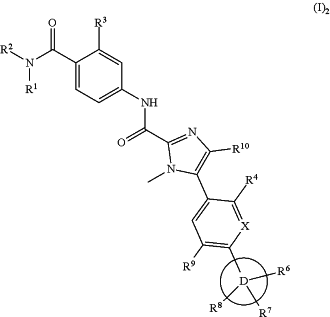| CPC C07D 401/14 (2013.01) [A61P 31/04 (2018.01); C07D 403/10 (2013.01); C07D 403/14 (2013.01)] | 16 Claims |
|
1. A compound of formula (I):
 or a pharmaceutically acceptable salt thereof, wherein:
X is N or C—R5;
R1 and R2, taken together with the nitrogen atom to which they are attached, form
 or
R1 is
 and R2 is hydrogen;
R3 is halogen or C1-C6-alkyl;
R4 is selected from the group consisting of hydrogen, halogen, C1-C6-alkyl, and C1-C6-alkoxy;
R5 is selected from the group consisting of hydrogen, halogen, and C1-C6-alkyl;
R6 is selected from the group consisting of hydrogen, C1-C6-alkyl, carbamoyl-C1-C6-alkyl-NH—, amino, halogen, hydroxy-C1-C6-alkyl, halo-C1-C6-alkyl, and
 R7 is selected from the group consisting of hydrogen, C1-C6-alkyl, C1-C6-alkoxy-C1-C6-alkyl-, hydroxy-C1-C6-alkyl, halo-C1-C6-alkyl, carbamoyl-C1-C6-alkyl, C1-C6-alkyl-NH—C(O)—C1-C6-alkyl-, C1-C6-alkyl-NH—C(O)—NH—C1-C6-alkyl-, cyano-C1-C6-alkyl, C1-C6-alkyl-SO2—C1-C6-alkyl-, halo-C1-C6-alkoxy-C1-C6-alkyl-, amino-C1-C6-alkoxy-C1-C6-alkyl-, and
 and R8 is selected from the group consisting of hydrogen, halogen, C1-C6-alkyl, halo-C1-C6-alkyl, and C1-C6-alkoxy-C1-C6-alkyl; or
R7 and R8, taken together with the atoms to which they are attached, form a 3- to 14-membered heterocycle;
R9 and R10 are each independently hydrogen or halogen;
RA is selected from the group consisting of hydrogen, (C1-C6-alkyl)2N-C1-C6-alkyl-C(O)—, (RA6)3N+—C1-C6-alkyl-C(O)—, and
 RA1 is selected from the group consisting of hydrogen, hydroxy, amino, C1-C6-alkyl, halo-C1-C6-alkyl, hydoxy-C1-C6-alkyl, amino-C1-C6-alkyl, carbamoyl-C1-C6-alkyl, C1-C6-alkoxy-C1-C6-alkyl, H2N-SO2—C1-C6-alkyl-, H2N—NH—C(O)—C1-C6-alkyl-, C1-C6-alkoxy, oxo, carbamoyl, and
 RA2 is selected from the group consisting of hydrogen, hydroxy, amino, C1-C6-alkyl, carboxy-C1-C6-alkyl, and carbamoyl-C1-C6-alkyl;
RA3, RA4, RA5, RC2, and RC3 are each independently hydrogen or C1-C6-alkyl;
each RA6 is independently selected from the group consisting of C1-C6-alkyl, amino-C1-C6-alkyl, C1-C6-alkyl-NH—C1-C6-alkyl-, (C1-C6-alkyl)2N-C1-C6-alkyl-, carboxy-C1-C6-alkyl, and (3- to 14-membered heterocyclyl)-C1-C6-alkyl-;
RA7 is hydrogen or C1-C6-alkyl;
RB1 is selected from the group consisting of hydrogen, halogen, cyano, amino, oxo, C1-C6-alkyl, C1-C6-alkoxy, and 3- to 14-membered heterocyclyl;
RB2 is selected from the group consisting of hydrogen, halogen, and C1-C6-alkyl;
RC is selected from the group consisting of hydrogen, (C1-C6-alkyl)2N-C1-C6-alkyl-C(O)—, (C1-C6-alkyl)3N+—C1-C6-alkyl-C(O)—, and
 RC1 is hydroxy;
RE is selected from the group consisting of C1-C6-alkyl, C1-C6-alkoxy, and halogen;
LA is selected from the group consisting of —C1-C6-alkyldiyl-, carbonyl, —C(O)—NH—, —NH-C(O)—, —C(O)—N(C1-C6-alkyl), —N(C1-C6-alkyl)-C(O)—, —C1-C6-alkyldiyl-C(O)—, and —C(O)—C1-C6-alkyldiyl-C(O)—;
LB is selected from the group consisting of a covalent bond, —C1-C6-alkyldiyl-, C(O)—C1-C6-alkyldiyl-, —C(O)—NH—C1-C6-alkyldiyl-, —C(O)—C1-C6-alkyldiyl-, and —SO2—NH—C1-C6-alkyldiyl-;
LC and LE are each independently a covalent bond or —C1-C6-alkyldiyl-;
LC1 is —NH-C(O)— or carbonyl;
A, C, and C1 are each independently a 3- to 14-membered heterocyclyl;
A2 is 3- to 14-membered heterocyclyl or C6-C10-aryl;
A1 is selected from the group consisting of 3- to 14-membered heterocyclyl, 5- to 14-membered heteroaryl, and C3-C10-cycloalkyl;
B is selected from the group consisting of 5- to 14-membered heteroaryl, 3- to 14-membered heterocyclyl, C3-C10-cycloalkyl, and C6-C10-aryl;
D is a 5- to 14-membered heteroaryl;
E is selected from the group consisting of 5- to 14-membered heteroaryl, 3- to 14-membered heterocyclyl, and C6-C10-aryl; and
a wavy line represents the point of attachment of the respective R group to the remainder of formula (I).
|